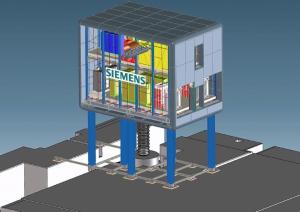Europe choses Siemens for heating system components
19 Oct 2015
The high voltage units for ITER neutral beam injection contain transformers, power distribution systems, and control cubicles in a two-story, 150 m² "cage."
The European Domestic Agency for ITER has chosen Siemens for the design, fabrication and testing of three high voltage units that will host the power supplies for ITER's most powerful heating system—neutral beam injection.
In ITER two neutral beam injectors will deliver high-energy beams of neutral deuterium atoms for long pulses to heat the plasma. Because these high-power systems are the first tokamak neutral beam systems based on a negative ion source, risk will be mitigated in advance of operation at the PRIMA neutral beam test facility currently under construction in Padua, Italy. Europe, Japan and India are contributing all components according to the specifications of Procurement Arrangements signed with the ITER Organization; Italy is building the facility as a voluntary contribution to the neutral beam development program.
PRIMA will host a full-size negative ion source (SPIDER) and a full-size heating neutral beam injector (MITICA). The components designed for the test beds are the same as those that will be used on the heating neutral beams in ITER.
Europe has chosen Siemens to design, manufacture and test three high voltage units—one for the MITICA test bed and two for ITER's powerful neutral beam injection system. Each large, two-storey unit will contain transformers, power distribution systems, and control cubicles and stand on post insulators over six metres tall. The total weight of each unit—structure and components included—will reach 100 metric tons.
The EUR 18 million, seven-year contract also includes the delivery of high voltage bushing assemblies to connect the power supplies to transmission lines.
Read the full report on the European Domestic Agency website.


